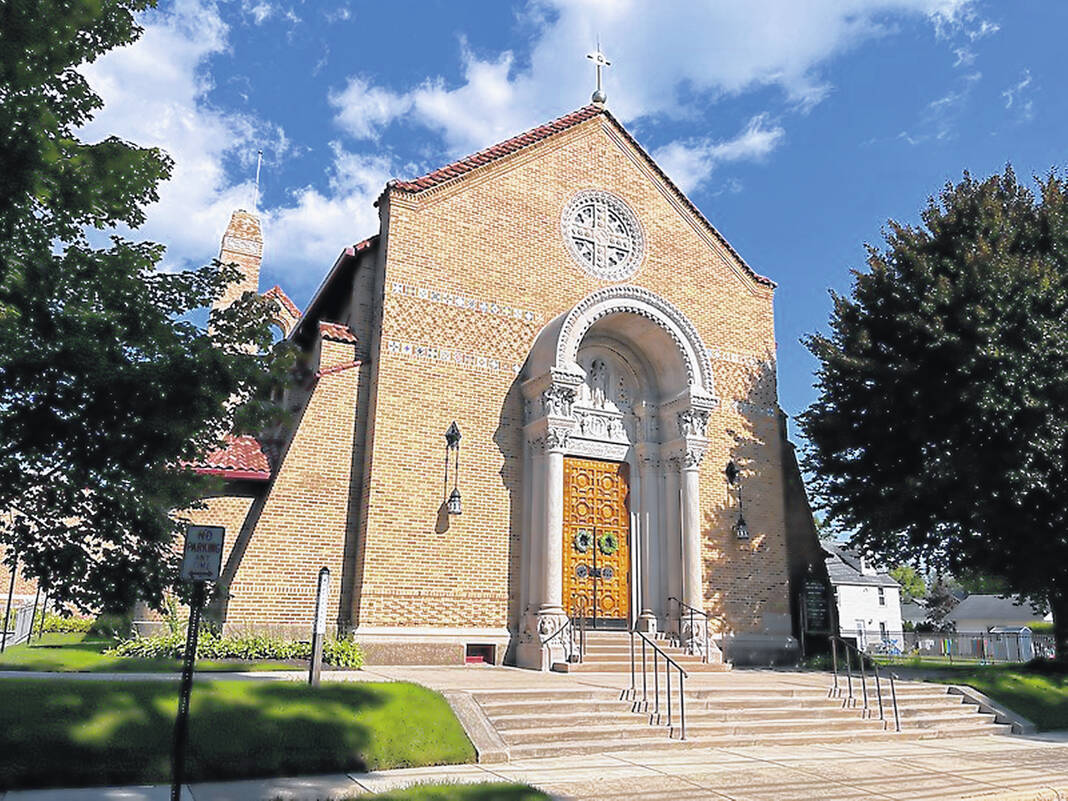
St. Aloysius Catholic Church
The Historic Preservation Commission of Bowling Green has selected St. Aloysius Catholic Church as its Historic Building of the Month for April to mark the 100th anniversary of the laying of the cornerstone of the church on June 29, 1924.
In the 1860s, the Catholic population in Bowling Green was so small it could not afford to build its own church. For many years, the congregation was a satellite of the churches in Maumee and Perrysburg.
The numbers of Catholics in and around Bowling Green increased as Irish and German workers came to the area to help build canals (1820s-1850s) and then railroads (1840s-1890s).
By the late 1870s, Catholics in Bowling Green had gone two years without a visit from a priest. In 1880, however, Father Hyacinthe Kolopp of St. Patrick’s decided it was finally time to build a Catholic church in Bowling Green.
This church was built on South Enterprise just north of Clough, using wood from the Bigelow Sawmill, which was on the land where the present-day church stands at the corner of Clough and South Summit. The bricks were also locally produced.
The new church received its name when the farmers who helped build it put their first names into a hat for a drawing. Aloysius Pfeiffer’s name was drawn, and thus St. Aloysius Gonzaga (1568-1591) became the patron saint of the new church.
This red brick church, dedicated in 1881, was just 35 x 50 feet, and the priest covered the plain windows with colored paper to imitate the effect of stained glass. The church was described as being drab and dark, with rough-hewn pews.
In 1884, a rectory was built and a bell tower was added a few years later. The one-ton bell is still being used in the current church.
In 1917, the church purchased the site of the Bigelow Sawmill and the original Bigelow home, which stood west of the brick church. By 1923, the congregation had raised about $35,000, and plans for a new church were finalized. The architect was John T. Comès of Pittsburgh, who also designed the Holy Rosary Cathedral in Toledo.
The Daily Sentinel-Tribune of Monday, June 30, 1924, reports: “A good-sized audience gathered to witness the laying of the cornerstone of St Aloysius new church at Clough and Summit streets, Sunday afternoon. Rt Rev Monsignor J. T. O’Connell, Vicar General of the Toledo diocese officiated at the impressive services. The procession formed at the old church and marched along Clough Street to the entrance of the new church. Louis Veler carried the cross and Otho and Otto Hunter were the candle- bearers. They were followed by 27 priests. … The cornerstone, placed on the left side of the church separating the sanctuary from the auditorium of the building, was blessed. It seemed a fitting day on which to hold the ceremony as the church celebrates the feast of Sts. Peter and Paul on June 29th.”
The new church was described as a “buff brick structure erected in Spanish Gothic with a California Mission motif accentuating its lines.” The Mission style is evident in the massive walls, the clay roof, and the colorful clay tile details, while Gothic elements include the delicate filigree over the main portal. The rounded arches reflect a Spanish Colonial Revival style.
The first mass was held in the new church on Feb. 14, 1926. The church was officially dedicated on Sunday, July 18, 1926.
Sometime in the late 1920s or early 1930s, Felix Lieftuchter decorated the church’s sanctuary with elaborate murals. Lieftuchter, who was born in Cincinnati in 1882 and educated in Germany, had a working relationship with John Comès, the architect of St. Aloysius, and he also painted murals in the Holy Rosary Cathedral in Toledo, the Toledo Central Catholic High School chapel, and churches in Cleveland, Salt Lake City, Utah, Wheeling, West Virginia, Pittsburgh, Johnstown, Pennsylvania, and Buffalo, New York.
The murals are distinguished by their Byzantine flatness, showing no depth of perspective, and their intricate geometric, tendril, and cloud patterns. Surrounding the wooden sculpture of Christ crucified are painted depictions in saturated colors of Christ’s image on the Veil of Veronica, the Holy Sacrifice of the Mass attended by adoring angels, seraphim, and the communion of saints (including St. Aloysius), and allegories of faith (fides), hope (spes), and love (caritas).
In the 1960s, these murals were painted over in a solid color. In 2007, a member of St. Aloysius approached Father Mark Davis and offered to fund the restoration. In 2014, after further funds were raised, Evergreene Architectural Arts of Brooklyn, New York, was engaged to remove what turned out to be five coats of paint, and to restore the brilliance of the original paintings.
In 1956-1960, St. Aloysius School, a convent (Clare Hall), and a rectory were built on the site of the original red brick church. In 1998, Létourneau organ builders of Quebec, Canada, installed a new pipe organ.
In 2022, under Father Tom McQuillen, St. Aloysius parish started a five-year capital campaign to improve the efficient use of space in the school and parish offices.
St. Aloysius is not only one of the most distinguished and beautiful historic buildings in Bowling Green, but also a great example of historic preservation and restoration in action.
(Written by Geoffrey C. Howes with information provided by Bob Kreienkamp of St. Aloysius. It has been edited for length.)

